2.6.2: Synthetic Division of Polynomials
- Page ID
- 14228
Synthetic Division of Polynomials
The volume of a rectangular prism is 2x3+5x2−x−6. Determine if 2x+3 is the length of one of the prism's sides.
Synthetic Division
Synthetic division is an alternative to long division. It can also be used to divide a polynomial by a possible factor, x−k. However, synthetic division cannot be used to divide larger polynomials, like quadratics, into another polynomial.
Let's use synthetic division to divide 2x4−5x3−14x2+47x−30 by x−2.
Using synthetic division, the setup is as follows:
 [Figure1]
[Figure1] [Figure2]
[Figure2] [Figure3]
[Figure3] [Figure4]
[Figure4] [Figure5]
[Figure5]To “read” the answer, use the numbers as follows:
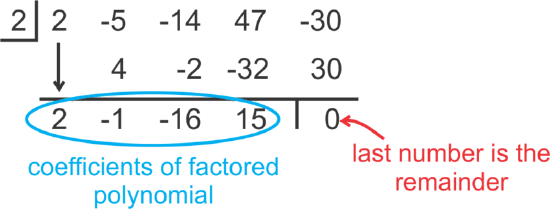 [Figure6]
[Figure6]Therefore, 2 is a solution, because the remainder is zero. The factored polynomial is 2x3−x2−16x+15. Notice that when we synthetically divide by k, the “leftover” polynomial is one degree less than the original. We could also write
(x−2)(2x3−x2−16x+15)=2x4−5x3−14x2+47x−30.
Now, let's determine if 4 is a solution to f(x)=5x3+6x2−24x−16.
Using synthetic division, we have:
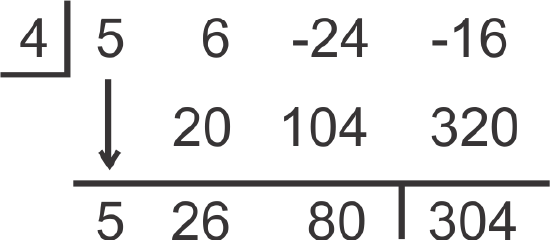 [Figure7]
[Figure7]The remainder is 304, so 4 is not a solution. Notice if we substitute in x=4, also written f(4), we would have f(4)=5(4)3+6(4)2−24(4)−16=304. This leads us to the Remainder Theorem.
Remainder Theorem: If f(k)=r, then r is also the remainder when dividing by (x−k).
This means that if you substitute in x=k or divide by k, what comes out of f(x) is the same. r is the remainder, but it is also the corresponding y−value. Therefore, the point (k,r) would be on the graph of f(x).
Finally, let's determine if (2x−5) is a factor of 4x4−9x2−100.
If you use synthetic division, the factor is not in the form (x−k). We need to solve the possible factor for zero to see what the possible solution would be. Therefore, we need to put \(\ \frac{5}{2}\) up in the left-hand corner box. Also, not every term is represented in this polynomial. When this happens, you must put in zero placeholders. In this problem, we need zeros for the x3−term and the x−term.
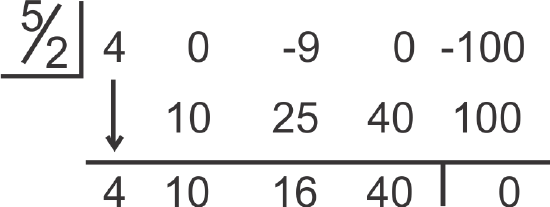 [Figure8]
[Figure8]This means that \(\ \frac{5}{2}\) is a zero and its corresponding binomial, (2x−5), is a factor.
Earlier, you were asked to determine if 2x+3 is the length of one of the prism's sides.
Solution
If 2x+3 divides evenly into 2x3+5x2−x−6 then it is the length of one of the prism's sides.
If we want to use synthetic division, notice that the factor is not in the form (x−k). Therefore, we need to solve the possible factor for zero to see what the possible solution would be. If 2x+3=0 then x=\(\ -\frac{3}{2}\). Therefore, we need to put \(\ -\frac{3}{2}\) up in the left-hand corner box.
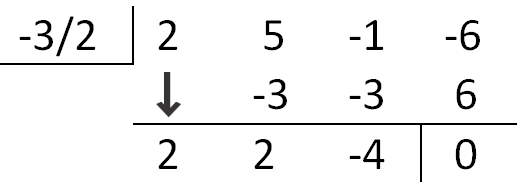
When we perform the synthetic division, we get a remainder of 0. This means that (2x+3) is a factor of the volume. Therefore, it is also the length of one of the sides of the rectangular prism.
Divide x3+9x2+12x−27 by (x+3). Write the resulting polynomial with the remainder (if there is one).
Solution
Using synthetic division, divide by -3.
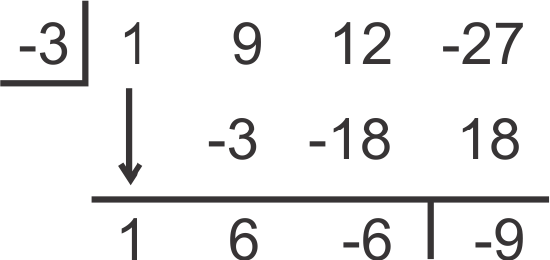 [Figure9]
[Figure9]The answer is \(\ x^{2}+6 x-6-\frac{9}{x+3}\).
Divide 2x4−11x3+12x2+9x−2 by (2x+1). Write the resulting polynomial with the remainder (if there is one).
Solution
Using synthetic division, divide by \(\ -\frac{1}{2}\).
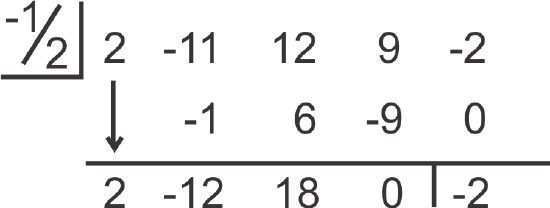 [Figure10]
[Figure10]The answer is \(\ 2 x^{3}-12 x^{2}+18 x-\frac{2}{2 x+1}\)
Is 6 a solution for f(x)=x3−8x2+72? If so, find the real-number zeros (solutions) of the resulting polynomial.
Solution
Put a zero placeholder for the x−term. Divide by 6.
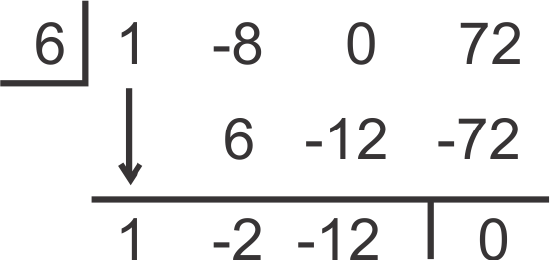
The resulting polynomial is x2−2x−12. While this quadratic does not factor, we can use the Quadratic Formula to find the other roots.
\(\ x=\frac{2 \pm \sqrt{2^{2}-4(1)(-12)}}{2}=\frac{2 \pm \sqrt{4+48}}{2}=\frac{2 \pm 2 \sqrt{13}}{2}=1 \pm \sqrt{13}\)
The solutions to this polynomial are \(\ 6,1+\sqrt{13} \approx 4.61 \text { and } 1-\sqrt{13} \approx-2.61\).
Review
Use synthetic division to divide the following polynomials. Write out the remaining polynomial.
- (x3+6x2+7x+10)÷(x+2)
- (4x3−15x2−120x−128)÷(x−8)
- (4x2−5)÷(2x+1)
- (2x4−15x3−30x2−20x+42)÷(x+9)
- (x3−3x2−11x+5)÷(x−5)
- (3x5+4x3−x−2)÷(x−1)
- Which of the division problems above generate no remainder? What does that mean?
- What is the difference between a zero and a factor?
- Find f(−2) if f(x)=2x4−5x3−10x2+21x−4.
- Now, divide 2x4−5x3−10x2+21x−4 by (x+2) synthetically. What do you notice?
Find all real zeros of the following polynomials, given one zero.
- 12x3+76x2+107x−20; −4
- x3−5x2−2x+10; −2
- 6x3−17x2+11x−2; 2
Find all real zeros of the following polynomials, given two zeros.
- x4+7x3+6x2−32x−32; −4, −1
- 6x4+19x3+11x2−6x; 0, −2
Answers for Review Problems
To see the Review answers, open this PDF file and look for section 6.10.
Vocabulary
| Term | Definition |
|---|---|
| Oblique Asymptote | An oblique asymptote is a diagonal line marking a specific range of values toward which the graph of a function may approach, but generally never reach. An oblique asymptote exists when the numerator of the function is exactly one degree greater than the denominator. An oblique asymptote may be found through long division. |
| Oblique Asymptotes | An oblique asymptote is a diagonal line marking a specific range of values toward which the graph of a function may approach, but generally never reach. An oblique asymptote exists when the numerator of the function is exactly one degree greater than the denominator. An oblique asymptote may be found through long division. |
| Remainder Theorem | The remainder theorem states that if f(k)=r, then r is the remainder when dividing f(x) by (x−k). |
| Synthetic Division | Synthetic division is a shorthand version of polynomial long division where only the coefficients of the polynomial are used. |
Image Attributions
- [Figure 1]
Credit: CK-12 Foundation
Source: http://centros5.pntic.mec.es/sierrami/dematesna/demates67/opciones/sabias/Ruffinni/Ruffinni.htm - [Figure 2]
Credit: CK-12 Foundation
Source: http://centros5.pntic.mec.es/sierrami/dematesna/demates67/opciones/sabias/Ruffinni/Ruffinni.htm - [Figure 3]
Credit: CK-12 Foundation
Source: http://centros5.pntic.mec.es/sierrami/dematesna/demates67/opciones/sabias/Ruffinni/Ruffinni.htm - [Figure 4]
Credit: CK-12 Foundation
Source: http://centros5.pntic.mec.es/sierrami/dematesna/demates67/opciones/sabias/Ruffinni/Ruffinni.htm - [Figure 5]
Credit: CK-12 Foundation
Source: http://centros5.pntic.mec.es/sierrami/dematesna/demates67/opciones/sabias/Ruffinni/Ruffinni.htm - [Figure 6]
Credit: CK-12 Foundation
Source: http://centros5.pntic.mec.es/sierrami/dematesna/demates67/opciones/sabias/Ruffinni/Ruffinni.htm - [Figure 7]
Credit: CK-12 Foundation
Source: http://centros5.pntic.mec.es/sierrami/dematesna/demates67/opciones/sabias/Ruffinni/Ruffinni.htm - [Figure 8]
Credit: CK-12 Foundation
Source: http://centros5.pntic.mec.es/sierrami/dematesna/demates67/opciones/sabias/Ruffinni/Ruffinni.htm - [Figure 9]
Credit: CK-12 Foundation
Source: http://centros5.pntic.mec.es/sierrami/dematesna/demates67/opciones/sabias/Ruffinni/Ruffinni.htm - [Figure 10]
Credit: CK-12 Foundation
Source: http://centros5.pntic.mec.es/sierrami/dematesna/demates67/opciones/sabias/Ruffinni/Ruffinni.htm

